Optimizing the Spectral Characterisation of a CMYK Printer with Embedded CMY Printer Modelling
Abstract
1. Introduction
2. Methodology
2.1. Ink Limitation
2.2. CYNSN-Based Forward Modelling
2.3. CYNSN-Based Backward Modelling
2.4. Embedded CMY Printer Modelling
3. Experiments
4. Results and Discussion
5. Conclusions
Author Contributions
Funding
Conflicts of Interest
References
- Deshpande, K.; Green, P.; Pointer, M.R. Characterisation of the n-colour printing process using the spot colour overprint model. Opt. Express 2014, 22, 31786–31800. [Google Scholar] [CrossRef] [PubMed]
- Liang, J.; Huang, H.; Lian, Y.S.; Ning, S.Y.; Sun, L. Study of the Multi-Spectral Characterization Model for Inkjet Printing System and Its Application. Spectrosc. Spectr. Anal. 2018, 38, 1213–1218. [Google Scholar]
- Sharma, G. Digital Color Imaging Handbook; CRC: New York, NY, USA, 2002; Volume 11. [Google Scholar]
- Morovic, J.; Morovic, P.; Arnabat, J. HANS: Controlling Ink-Jet Print Attributes Via Neugebauer Primary Area Coverages. IEEE Trans. Image Process. 2012, 21, 688–696. [Google Scholar] [CrossRef] [PubMed]
- Liu, Q.; Huang, Z.; Li, Q.; Peng, R.; Xun, Y. Updating a Spectral Printer Characterization Model Based on Ink Limitation Samples. Spectrosc. Spectr. Anal. 2018, 38, 3182–3187. [Google Scholar]
- Gerbl, A.; Lewin, M.; Zeiske, T.; Ziegert, M.; Schwarz, F.B.; Hamm, B.; Scheel, M.; Jahnke, P. Characterization of office laser printers for 3-D printing of soft tissue CT phantoms. J. Med Imaging 2019, 6, 021602. [Google Scholar] [CrossRef]
- Wyble, D.R.; Berns, R.S. A critical review of spectral models applied to binary color printing. Color Res. Appl. 2000, 25, 4–19. [Google Scholar] [CrossRef]
- Xi, S.; Zhang, Y. Neugebauer reflectance model of frequency modulation halftone image. Optik 2013, 124, 2103–2105. [Google Scholar] [CrossRef]
- Zhang, Y.; Shi, G. Empirical and probability models of the spectral reflectance for the frequency modulated halftoning imaging. Opt.-Int. J. Light Electron Opt. 2012, 124, 28–30. [Google Scholar] [CrossRef]
- Zhang, Y.; Xing, W. Reflectance prediction model of frequency modulation halftone image copied by variable dot-volume press. Opt.-Int. J. Light Electron Opt. 2012, 124, 1730–1735. [Google Scholar] [CrossRef]
- Chen, Y.; Berns, R.S.; Taplin, L.A.; Imai, F. Six color printer characterization using an optimized cellular Yule-Nielsen spectral Neugebauer model. J. Imaging Sci. Technol. 2004, 48, 519–528. [Google Scholar]
- Chen, Y.; Berns, R.; Taplin, L.; Imai, F. Multi-ink color-separation algorithm improving image quality. J. Imaging Sci. Technol. 2008, 52, 20604. [Google Scholar] [CrossRef]
- Urban, P.; Grigat, R.R. Spectral based color separation using linear regression iteration. Color Res. Appl. 2006, 31, 229–238. [Google Scholar] [CrossRef]
- Li, C.; Luo, M.R. Further accelerating the inversion of the yule-nielson modified neugebauer model. In Proceedings of the 16th Color Imaging Conference: Color Science and Engineering Systems, Technologies, and Applications, Portland, OR, USA, 6–9 November 2001; pp. 84–88. [Google Scholar]
- Liu, Z.; Liu, Q.; Gao, G.-A.; Li, C. Optimized spectral reconstruction based on adaptive training set selection. Opt. Express 2017, 25, 12435–12445. [Google Scholar] [CrossRef] [PubMed]
- Gerhardt, J.; Hardeberg, J.Y. Spectral color reproduction minimizing spectral and perceptual color differences. Color Res. Appl. 2008, 33, 494–504. [Google Scholar] [CrossRef]
- Zhang, X.; Wang, Q.; Li, J.; Yang, P.; Yu, J. The interim connection space based on human color vision for spectral color reproduction. J. Opt. Soc. Am. A Opt. Image Sci. Vis. 2012, 29, 1027–1034. [Google Scholar] [CrossRef]
- Urban, P.; Berns, R. Paramer Mismatch-Based Spectral Gamut Mapping. IEEE Trans. Image Process. 2010, 20, 1599–1610. [Google Scholar] [CrossRef]
- Liu, Q.; Wan, X.; Xie, D. Optimization of spectral printer modeling based on a modified cellular Yule–Nielsen spectral Neugebauer model. JOSA A 2014, 31, 1284–1294. [Google Scholar] [CrossRef]
- Sun, B.; Liu, H.; Zhou, S.; Cao, C.; Zheng, Y. Modified Spectral Neugebauer Model for Printer Characterization. Spectrosc. Lett. 2015, 48, 660–668. [Google Scholar] [CrossRef]
- Guo, J.; Xu, H.; Luo, M.R. Novel spectral characterization method for color printer based on the cellular Neugebauer model. Chin. Opt. Lett. 2010, 8, 1106–1109. [Google Scholar]
- Shen, H.L.; Zheng, Z.H.; Jin, C.C.; Du, X.; Shao, S.J.; Xin, J.H. Adaptive characterization method for desktop color printers. J. Electron. Imaging 2013, 22, 023012. [Google Scholar] [CrossRef][Green Version]
- Shaw, M.; Sharma, G.; Bala, R.; Dalal, E.N. Color printer characterization adjustment for different substrates. Color Res. Appl. 2003, 28, 454–467. [Google Scholar] [CrossRef]
- Littlewood, D.; Subbarayan, G. Updating a CMYK printer model using a sparse data set. J. Imaging Sci. Technol. 2006, 50, 556–566. [Google Scholar] [CrossRef]
- Son, C.H.; Jang, I.S.; Lee, T.H.; Ha, Y.H. Photo-inkjet printing method based on limited colorant amount and dot-visibility ordering. IEEE Trans. Consum. Electron. 2010, 56, 280–288. [Google Scholar] [CrossRef]
- Rossier, R.; Bugnon, T.; Hersch, R.D. Introducing Ink Spreading within the Cellular Yule-Nielsen Modified Neugebauer Model; Society for Imaging Science and Technology: Springfield, WV, USA, 2010. [Google Scholar]
- Wang, B.; Xu, H.; Luo, M.R.; Guo, J. Spectral-based color separation method for a multi-ink printer. Chin. Opt. Lett. 2011, 9, 063301. [Google Scholar] [CrossRef]
- Wang, B.; Xu, H.; Luo, M.R.; Guo, J. Maintaining accuracy of cellular Yule–Nielsen spectral Neugebauer models for different ink cartridges using principal component analysis. JOSA A 2011, 28, 1429–1435. [Google Scholar] [CrossRef]
- Bianco, S.; Schettini, R. Sampling optimization for printer characterization by direct search. IEEE Trans. Image Process. 2012, 21, 4868–4873. [Google Scholar] [CrossRef]
- Morovic, J.; Arnabat, J.; Richard, Y.; Albarran, A. Sampling optimization for printer characterization by greedy search. IEEE Trans. Image Process. 2010, 19, 2705–2711. [Google Scholar] [CrossRef]
- Luo, M.R.; Cui, G.; Rigg, B. The development of the CIE 2000 colour-difference formula: CIEDE2000. Color Res. Appl. 2001, 26, 340–350. [Google Scholar] [CrossRef]
- Liu, Q. Research on Key Issues for Spectral-Based Inkjet Color Reproduction; Wuhan University: Wuhan, China, 2013. [Google Scholar]
- Liu, Q.; Wan, X.X.; Xu, H.P. Study on ink restriction of ink-jet printing based on spectral gamut maximization. Spectrosc. Spectr. Anal. 2013, 33, 1636–1641. [Google Scholar] [CrossRef]
- Urban, P. Ink limitation for spectral or color constant printing. In Proceedings of the 11th Congress of the Int’l. Colour Assn, Sydney, Australia, 18–26 January 2009. [Google Scholar]
- Demichel, E. Le Procédé. Société Française de Photographie 1924, 26, 17–21. [Google Scholar]
- Yule, J.A.C.; Nielsen, W.J. The Penetration of Light into Paper and Its Effect on Halftone Reproduction; Institute of Science and Technology, Linkping University: Norrköping, Sweden, 1951. [Google Scholar]
- Rogers, G. Analysis of the Yule-Nielsen effect with the multiple-path point spread function in a frequency-modulated halftone. J. Opt. Soc. Am. A 2018, 35, 916. [Google Scholar] [CrossRef] [PubMed]
- Balasubramanian, R. Optimization of the spectral Neugebauer model for printer characterization. J. Electron. Imaging 1999, 8, 156–166. [Google Scholar] [CrossRef]
- Imai, F.H.; Rosen, M.R.; Berns, R.S. Comparative study of metrics for spectral match quality. In Proceedings of the CGIV, Poitiers, France, 2–5 April 2002; pp. 492–496. [Google Scholar]
- Taplin, L.A. Spectral Modeling of a Six-Color Inkjet Printer; Rochester Institute of Technology: Rochester, NY, USA, 2001. [Google Scholar]
- Schanda, J. CIE Colorimetry; Wiley Online Library: Hoboken, NJ, USA, 2007. [Google Scholar]
- Chong, E.K.; Zak, S.H. An Introduction to Optimization; Wiley: Chichester, UK, 2013. [Google Scholar]
- ICC. ICC Specification. Available online: www.color.org (accessed on 16 November 2019).
- Tzeng, D.Y. Spectral-Based Color Separation Algorithm Development for Multiple-Ink Color Reproduction; Citeseer: Forest Grove, OR, USA, 1999. [Google Scholar]
- Urban, P.; Rosen, M.R.; Berns, R.S. Spectral gamut mapping framework based on human color vision. In Conference on Colour in Graphics, Imaging, and Vision; Society for Imaging Science and Technology: Cambridge, MA, USA, 2008; Volume 2008. [Google Scholar]
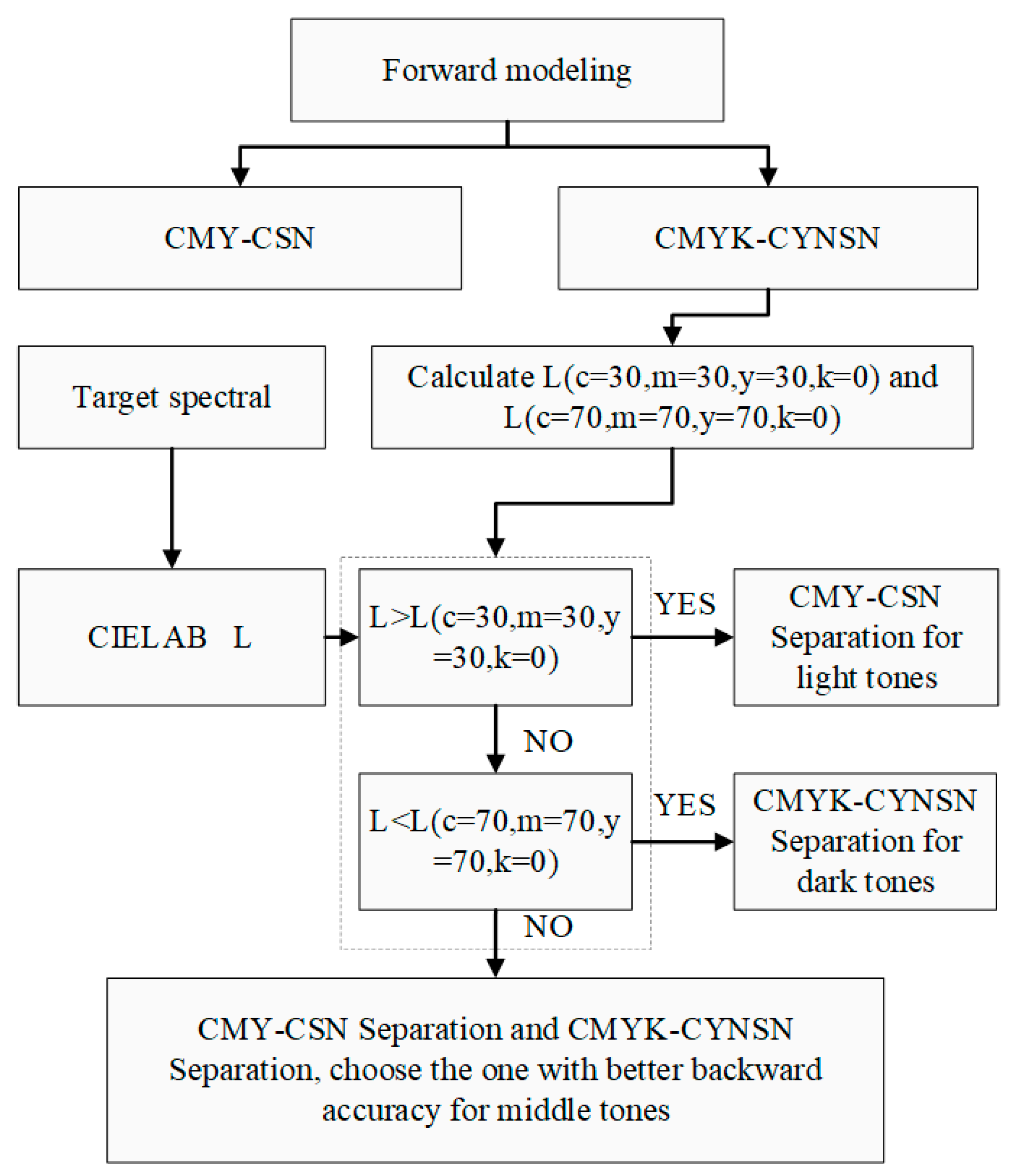


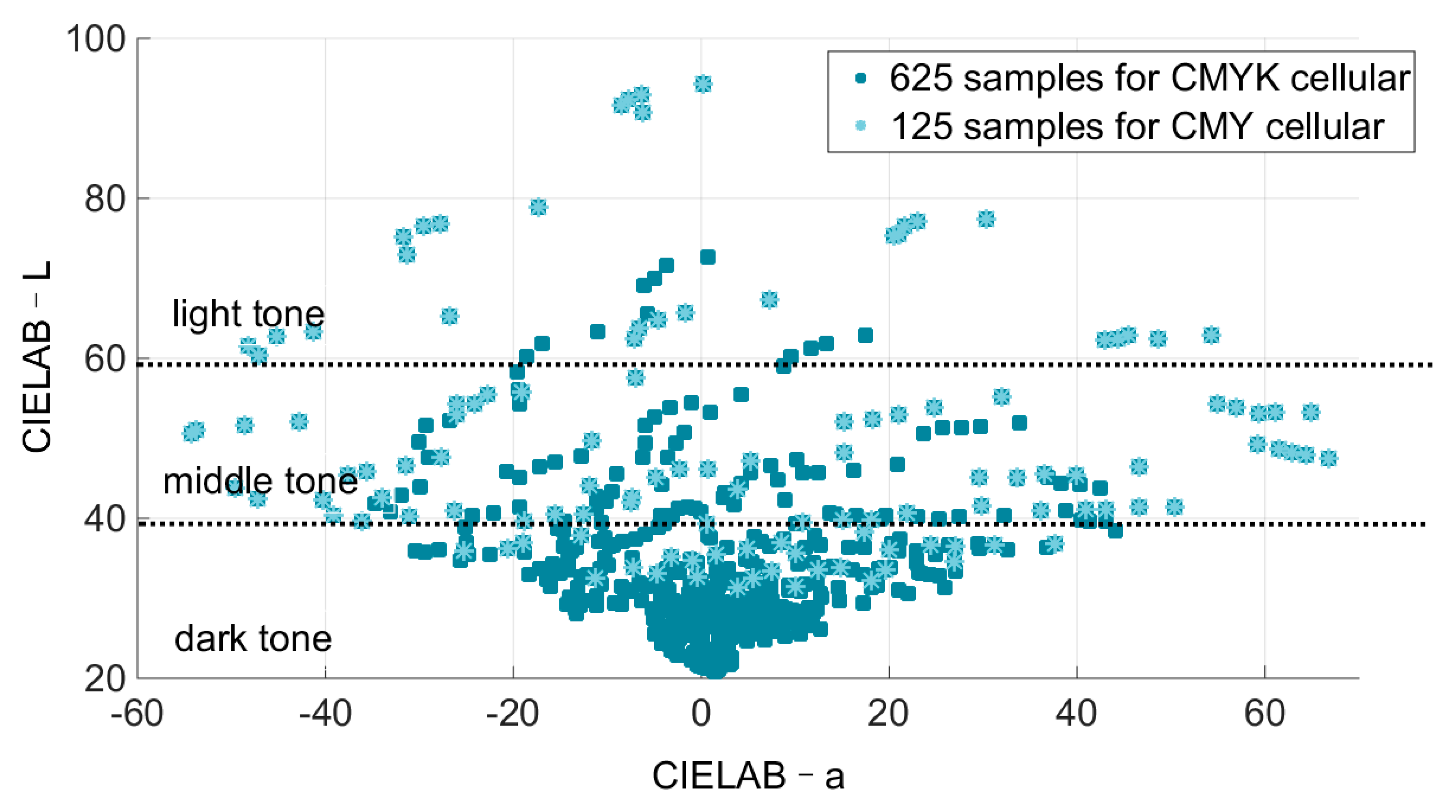

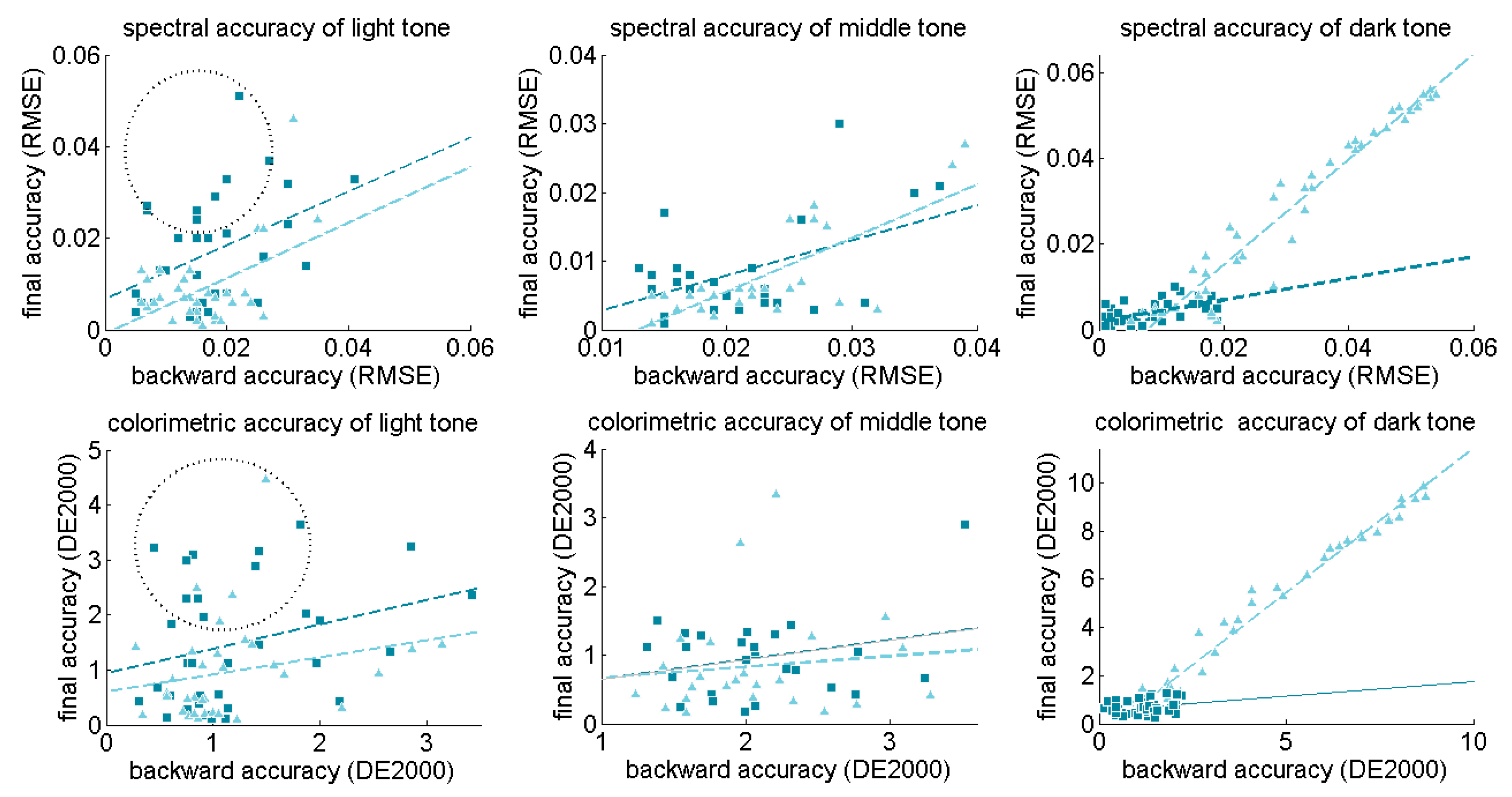
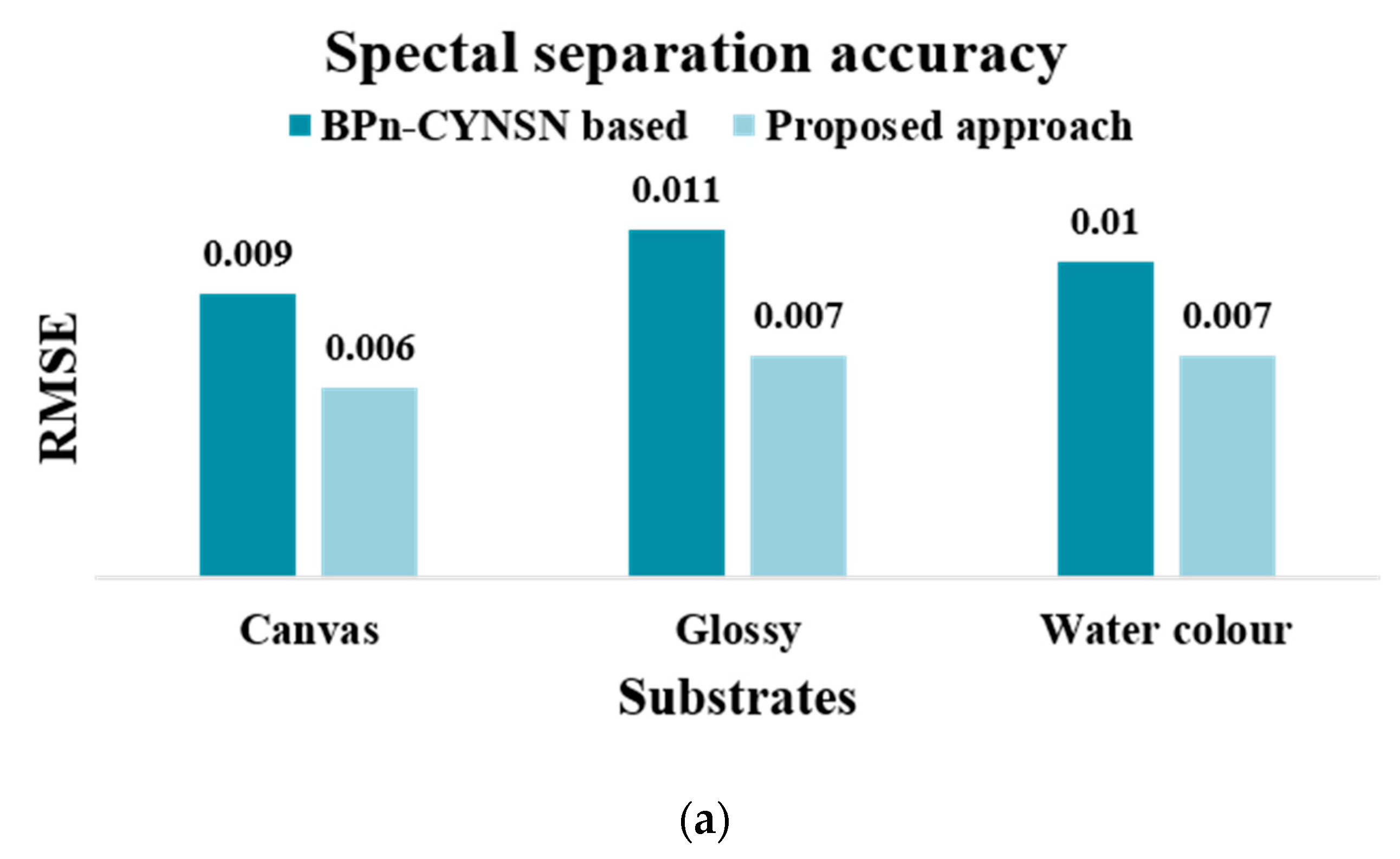
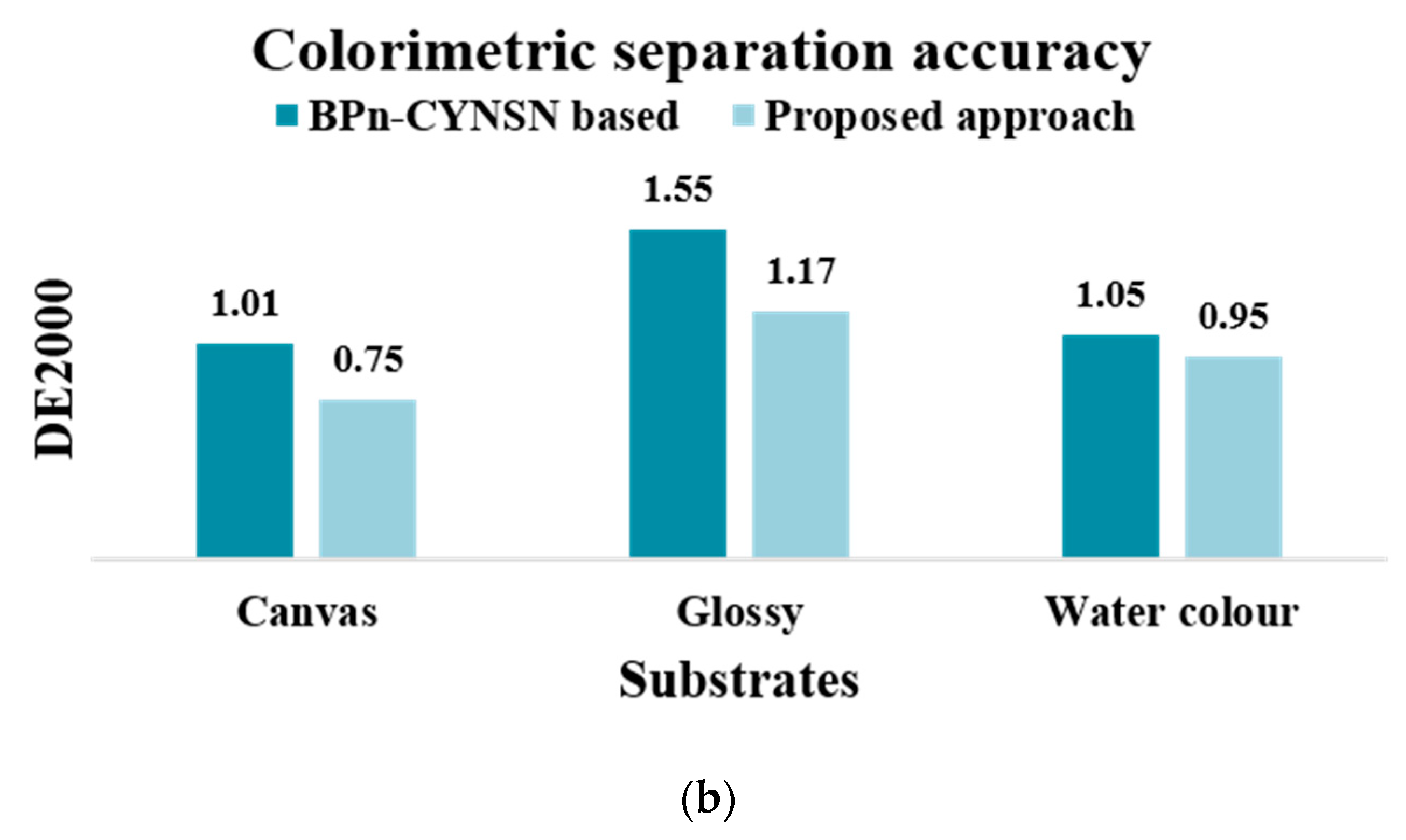
| Primary | Maximum Total Ink Amount | ||
|---|---|---|---|
| Canvas | Glossy | Water Colour | |
| Paper | (0, 0, 0, 0) | (0, 0, 0, 0) | (0, 0, 0, 0) |
| C | (0.9, 0, 0, 0) | (1, 0, 0, 0) | (0.7, 0, 0, 0) |
| M | (0, 0.8, 0, 0) | (0, 1, 0, 0) | (0, 0.65, 0, 0) |
| Y | (0, 0, 0.9, 0) | (0, 0, 1, 0) | (0, 0, 0.9, 0) |
| K | (0, 0, 0, 0.6) | (0, 0, 0, 1) | (0, 0, 0, 0.65) |
| CM | (0.6, 0.6, 0, 0) | (0.8, 0.8, 0, 0) | (0.45, 0.45, 0, 0) |
| CY | (0.85, 0, 0.85, 0) | (0.9, 0, 0.9, 0) | (0.55, 0, 0.55, 0) |
| CK | (0.65, 0, 0, 0.65) | (0.85, 0, 0, 0.85) | (0.55, 0, 0, 0.55) |
| MY | (0, 0.75, 0, 0.75) | (0, 0.95, 0, 0.95) | (0, 0.6, 0, 0.6) |
| MK | (0, 0.6, 0, 0.6) | (0, 0.7, 0, 0.7) | (0, 0.6, 0, 0.6) |
| YK | (0, 0, 0.7, 0.7) | (0, 0, 0.85, 0.85) | (0, 0, 0.75, 0.75) |
| CMY | (0.7, 0.7, 0.7, 0) | (0.8, 0.8, 0.8, 0) | (0.45, 0.45, 0.45, 0) |
| CMK | (0.55, 0.55, 0, 0.55) | (0.65, 0.65, 0, 0.65) | (0.45, 0.45, 0, 0.45) |
| CYK | (0.75, 0, 0.75, 0.75) | (0.75, 0, 0.75, 0.75) | (0.5, 0, 0.5, 0.5) |
| MYK | (0, 0.55, 0.55, 0.55) | (0, 0.7, 0.7, 0.7) | (0, 0.55, 0.55, 0.55) |
| CMYK | (0.5, 0.5, 0.5, 0.5) | (0.65, 0.65, 0.65, 0.65) | (0.45, 0.45, 0.45, 0.45) |
| CMYK-BPn-CYNSN | CMY-CSN | ||||
|---|---|---|---|---|---|
| RMS | DE2000 | RMS | DE2000 | ||
| Canvas | Light Tone | 0.017 | 1.48 | 0.009 | 0.96 |
| Middle Tone | 0.008 | 0.96 | 0.008 | 0.83 | |
| Dark Tone | 0.004 | 0.69 | 0.028 | 4.37 | |
| Glossy | Light Tone | 0.019 | 1.78 | 0.013 | 0.99 |
| Middle Tone | 0.014 | 1.39 | 0.008 | 1.05 | |
| Dark Tone | 0.004 | 1.48 | 0.007 | 2.70 | |
| Water Colour | Light Tone | 0.016 | 1.26 | 0.011 | 1.09 |
| Middle Tone | 0.009 | 0.99 | 0.006 | 0.89 | |
| Dark Tone | 0.005 | 0.92 | 0.060 | 8.00 | |
© 2019 by the authors. Licensee MDPI, Basel, Switzerland. This article is an open access article distributed under the terms and conditions of the Creative Commons Attribution (CC BY) license (http://creativecommons.org/licenses/by/4.0/).
Share and Cite
Liu, Q.; Huang, Z.; Pointer, M.R.; Luo, M.R. Optimizing the Spectral Characterisation of a CMYK Printer with Embedded CMY Printer Modelling. Appl. Sci. 2019, 9, 5308. https://doi.org/10.3390/app9245308
Liu Q, Huang Z, Pointer MR, Luo MR. Optimizing the Spectral Characterisation of a CMYK Printer with Embedded CMY Printer Modelling. Applied Sciences. 2019; 9(24):5308. https://doi.org/10.3390/app9245308
Chicago/Turabian StyleLiu, Qiang, Zheng Huang, Michael R. Pointer, and M. Ronnier Luo. 2019. "Optimizing the Spectral Characterisation of a CMYK Printer with Embedded CMY Printer Modelling" Applied Sciences 9, no. 24: 5308. https://doi.org/10.3390/app9245308
APA StyleLiu, Q., Huang, Z., Pointer, M. R., & Luo, M. R. (2019). Optimizing the Spectral Characterisation of a CMYK Printer with Embedded CMY Printer Modelling. Applied Sciences, 9(24), 5308. https://doi.org/10.3390/app9245308




